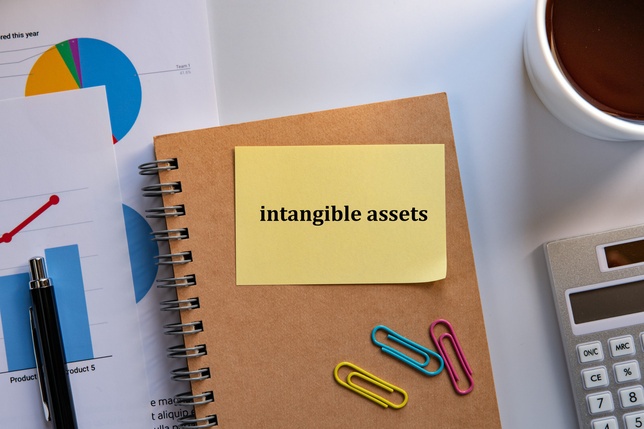Every asset counts when assessing the value of a company. It’s also easy to focus on physical things like buildings, machinery, and equipment. However, a growing portion of company value today comes from things you can’t see or touch. These are intangible assets. They have no physical presence but can have a huge impact on a company’s valuation. This is even more common in sectors like tech, healthcare, and consumer brands. Intellectual property and reputation are often crucial.
For M&A professionals, understanding intangible assets is critical. They can make or break a deal and often need nuanced strategies for valuation and integration.
Defining Intangible Assets
Intangible assets are non-physical resources or rights that contribute to a company’s long-term profitability. While these assets don’t take up space in a warehouse, their impact can be far-reaching. Intangible assets range from legal rights like patents to the goodwill a brand has among customers. Although, they are often difficult to quantify and value. They require a different approach than traditional assets.
For M&A deals, the value of intangible assets cannot be understated. In many cases, the strength of a company’s brand, intellectual property, or proprietary technology is what makes it an acquisition target.
Intangible Asset Examples
- Patents: Legal rights that give companies exclusive control over an invention for a specific period.
- Trademarks: Protects logos, names, or symbols that identify a company, product, or service.
- Brand Recognition: A strong brand can have immense value, built on trust, reputation, and consumer loyalty.
- Copyrights: Legal protection for creative works, including music, books, and software.
- Goodwill: The value derived from a company’s reputation and relationships, often calculated during M&A deals.
- Customer Relationships: Established relationships with key clients can be an asset if they provide reliable revenue streams.
How Do Intangible Assets Compare to Tangible Assets?
Tangible assets, as the name suggests, are physical things you can touch and measure. These include things like real estate, machinery, vehicles, and inventory. Intangible assets, in contrast, exist in more abstract forms—legal protections, intellectual property, or brand reputation.
While both tangible and intangible assets add to the overall value of a company, they do so in different ways. Tangible assets often depreciate over time as they wear out or become obsolete. Intangible assets, however, can increase in value. This can happen when a brand strengthens its reputation or gains a groundbreaking patent.
Key Differences Tangible vs. Intangible Assets
- Tangible Assets: Physical objects like property, machinery, and inventory.
- Intangible Assets: Non-physical assets like patents, brands, and customer relationships.
- Depreciation vs. Appreciation: Tangible assets usually depreciate over time, while intangible assets can increase in value if managed well.
- Valuation Challenges: Tangible assets are often easier to value as they have a market price or known replacement cost. On the other hand, intangible assets often require expert analysis to determine their worth.
How Are Intangible Assets Valued?
Valuing intangible assets is more of an art than a science. Since they lack a physical presence, their worth is often based on their potential to generate future profits. This can come from enhancing a company’s market position and many other benefits. When dealing with intangible assets in an M&A transaction, it’s good to use a customized valuation method for the specific type of asset.
For instance, you might value a patent based on its potential to generate licensing revenue. You could also evaluate brand recognition with market surveys or revenue comparisons with competitors.
Methods for Valuing Intangible Assets
- Income Approach: Estimates the future revenue and earnings that the asset is likely to generate. Analysts often use this for patents and proprietary technologies.
- Market Approach: Compares the intangible asset to similar assets that have been sold in the marketplace. You’ll often find this approach with trademarks and brands.
- Cost Approach: Calculates the cost of recreating the asset from scratch, which can be useful for valuing customer relationships or software.
- Relief from Royalty Method: Determines the value of an intangible asset based on its cost savings. This is the result from owning the asset, rather than paying royalties to use it.
The Role that Intangible Assets Play in M&A Deals
Intangible assets are often the hidden gems in an M&A deal. Factories and physical infrastructure are often easier to value. This provides less opportunities to acquire undervalued assets., Instead, it’s the brand, intellectual property, or customer base that can sometimes unlock more value. Buyers might also be willing to pay a premium for a company with intangible assets, even if its tangible assets are modest.
In sectors like technology, healthcare, and entertainment, intangible assets can dominate the conversation during an acquisition. For instance, in the tech industry, a company’s proprietary software or a patent can be far more valuable than any physical asset. Similarly, in consumer industries, a strong brand can drive up the price of an acquisition.
Intangible Assets in M&A Deals
- Increasing Deal Value: Strong intangible assets can lead to a higher valuation for the target company. This can justify a premium price compared to competitors.
- Defining Strategic Fit: Acquiring a company for its patents or proprietary technology can offer the buyer a competitive edge in the market.
- Post-Acquisition Integration: The value of intangible assets like brand reputation or customer relationships can change after an acquisition. Advisors can help you better integrate companies and preserve the value of these assets.
Intangible Asset Key Takeaways
Intangible assets may not be as visible as office buildings or machinery, but their impact on a company’s value is undeniable. As the economy continues to shift towards knowledge-based industries, intangible assets will grow in value. For companies involved in M&A, understanding and valuing these assets is crucial to structuring a successful deal. Here are some key takeaways:
- The Differences Between Tangible and Intangible Assets: Tangible assets are physical things, while intangible assets are non-physical like patents and trademarks.
- The Relevance of Both in M&A: Intangible assets often carry weight in determining a company’s value, especially in industries like tech and healthcare.
- How Advisors Can Help Navigate Valuations: Experienced M&A advisors are essential for accurately valuing intangible assets. This helps with structuring deals to maximize their returns and reduce risk.
We hope that you’ve found this article valuable for learning about intangible assets. If you’re interested in reading more, please subscribe below to get alerted of new articles as we write them.





